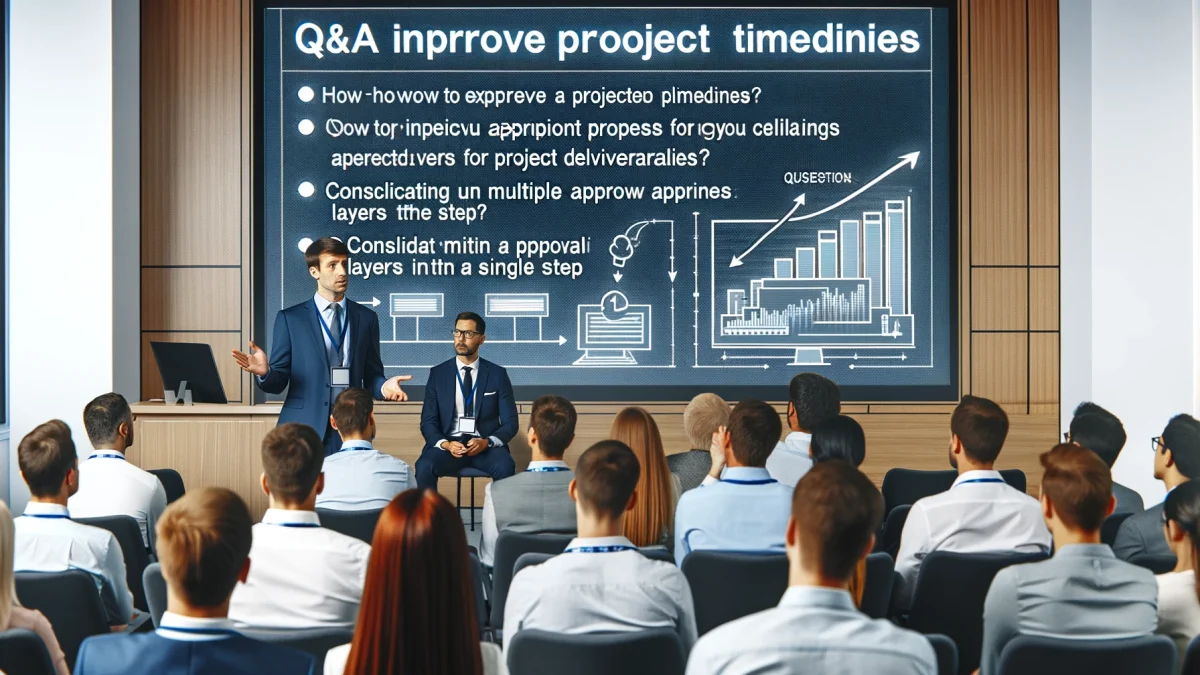問題1:
You are attending a project management seminar. The speaker is discussing strategies to improve project timelines. During the Q&A session, you ask, “How can we 【 】 the approval process for project deliverables?”
a) Consolidate multiple approval layers into a single step
b) Increase the number of project meetings
c) Extend the review period for feedback
d) Implement electronic approval systems
あなたはプロジェクト管理に関するセミナーに参加しています。講演者がプロジェクトのタイムラインを改善する戦略について話しています。質疑応答のセッションで、あなたは「プロジェクトの成果を確認・承認する手続きをどのように【 】できますか?」と質問します。
選択肢とその解説:
a) Consolidate multiple approval layers into a single step(複数の承認レイヤーを一つのステップに統合する)
- 正解: 承認プロセスにおける複数のレイヤーを一つに統合することで、手続きを簡略化し、プロセスの速度を向上させることができます。これにより無駄な時間を削減し、全体の効率を高めることが可能です。
b) Increase the number of project meetings(プロジェクト会議の回数を増やす)
- 不正解: 会議の回数を増やすことは、議論や意思決定の機会を増やすかもしれませんが、それが必ずしも承認プロセスの迅速化につながるわけではありません。多くの場合、会議はプロセスを遅くする要因となり、迅速化の目的には反する可能性が高いです。
c) Extend the review period for feedback(フィードバックのためのレビュー期間を延長する)
- 不正解: レビュー期間を延長することは、承認プロセスを遅らせることになります。これは迅速化を目指す質問の目的に反するため、不正解です。
d) Implement electronic approval systems(電子承認システムを導入する)
- 不正解: 電子承認システムを導入すること自体はプロセスの効率化に寄与しますが、複数の承認レイヤーを単一のステップに統合するほどの直接的な迅速化効果は期待できないかもしれません。この選択肢もプロセスを迅速化する方法としては有効ですが、他の選択肢と比較した場合、最も直接的で効果的な方法とは言えません。
このため、選択肢aがこの質問の文脈において最も適切で、効果的な解答となります。他の選択肢は承認プロセスを迅速化するという目的に沿っていないため不正解とされます。
Choices and their explanations:
a) Consolidate multiple approval layers into a single step
- Correct: By consolidating multiple layers of approval into a single step, the process can be simplified and sped up. This reduces unnecessary time expenditure and enhances overall efficiency.
b) Increase the number of project meetings
- Incorrect: Increasing the number of meetings might provide more opportunities for discussion and decision-making, but it does not necessarily expedite the approval process. Often, meetings can slow down processes and may work against the objective of speeding things up.
c) Extend the review period for feedback
- Incorrect: Extending the review period will delay the approval process. This is contrary to the goal of expediting the process, making it an incorrect choice.
d) Implement electronic approval systems
- Incorrect: While implementing electronic approval systems can contribute to process efficiency, it may not have the direct expeditive effect that consolidating multiple approval layers into a single step would have. Although this option is effective in speeding up processes, compared to the other options, it is not the most direct and effective method.
Therefore, choice a) is the most appropriate and effective answer in the context of this question. The other options do not align with the objective of expediting the approval process and are therefore incorrect.
問題2:
You are attending a marketing conference. The speaker is presenting a case study on successful product launches. At the end of the session, you approach the speaker and ask, “Could you provide some tips on how to efficiently manage the market research phase to meet tight deadlines?”
a) Automate data collection
b) Ignore qualitative data
c) Prioritize key metrics
d) Extend the timeline
マーケティング会議に出席しています。スピーカーは成功した製品の発売に関する事例研究を発表しています。セッションの終了時に、あなたはスピーカーに近づき、「タイトな期限に合わせて市場調査の段階を効率的に管理するためのヒントをいくつか提供していただけますか?」と尋ねます。
問題2の正解は「a) Automate data collection」です。
ここでの質問は、市場調査フェーズを効率的に管理して厳しい締め切りに間に合わせる方法について尋ねています。この文脈では、プロセスの速度を上げるための具体的な対策が求められます。
それぞれの選択肢について解説します:
a) Automate data collection (データ収集を自動化する)
- 正解:データ収集を自動化することで、手作業による時間の消費を削減し、データ処理の速度と精度を向上させることができます。市場調査を効率的に進めるための有効な手段であり、締め切りに追われる状況において特に役立ちます。
b) Ignore qualitative data (定性的データを無視する)
- 不正解:定性的データを無視することは、市場調査の質を落とす可能性があり、全体的な理解に欠ける結果をもたらす可能性があります。市場のニーズや消費者の意見を正確に把握するためには、質的データも重要です。
c) Prioritize key metrics (重要な指標を優先する)
- 不正解:重要な指標を優先すること自体は市場調査の質を保ちつつ効率を考慮する適切なアプローチですが、これが市場調査の速度を直接的に上げるわけではありません。締め切りに追われる状況では、もっと積極的な時間短縮策が必要です。
d) Extend the timeline (タイムラインを延長する)
- 不正解:タイムラインを延長することは、締め切りを遵守するという問題の初期設定に反します。この選択肢は、問題解決にはならず、むしろ問題を回避する方法であるため不適切です。
したがって、これらの理由から「a) Automate data collection」が最も適切な選択肢となります。
The correct answer for Question 2 is “a) Automate data collection”.
This question asks for tips on how to efficiently manage the market research phase to meet tight deadlines. In this context, specific measures to speed up the process are required.
Here’s an explanation for each choice:
a) Automate data collection
- Correct: Automating data collection reduces the time consumed by manual operations and enhances the speed and accuracy of data processing. It is an effective method for efficiently progressing through market research, especially when facing tight deadlines.
b) Ignore qualitative data
- Incorrect: Ignoring qualitative data can degrade the quality of the market research and result in an incomplete understanding. Qualitative data is important for accurately grasping market needs and consumer opinions.
c) Prioritize key metrics
- Incorrect: While prioritizing key metrics is a valid approach for considering efficiency while maintaining research quality, it doesn’t directly speed up the market research process. More proactive time-saving measures are needed under tight deadlines.
d) Extend the timeline
- Incorrect: Extending the timeline contradicts the initial goal of meeting deadlines. This option does not solve the problem but rather avoids it, making it inappropriate.
Therefore, “a) Automate data collection” is the most suitable choice given these reasons.

